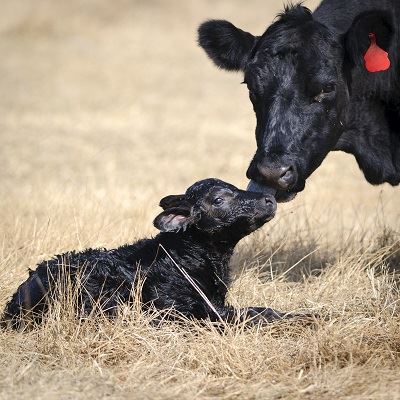Calving Season
Feb 17, 2020

It’s calving season! Get your calves off to the best start by understanding the complex digestive system a calf develops. Newborn calves are considered pre-ruminants. When calves are born they have all four compartments within the stomach but do not utilize the rumen to the full extent. The four parts of the stomach include: the rumen, reticulum, omasum, and abomasum. When a calf is born the largest compartment is the abomasum at 70% of the digestive tract. This is contrary to a cow where the rumen is the largest compartment (70%) in the digestive system. When a calf is born the immature digestive system acts similarly to that of a monogastric animal and relies on milk as a source of carbohydrates and proteins.
How does this happen? When a calf goes through the act of suckling this causes a fold of muscle to develop in the wall of the rumen. This wall is called the reticular groove. This groove allows milk to be delivered directly to the abomasum (the true stomach) and bypass the other compartments. This happens by the angle the calf is suckling from the cow to allow a direct line to deposit the milk into the abomasum. Additionally, when a calf is born the rumen is smooth in appearance with no texture or papilla growth.
As calves begin to consume forages as a part of their diet, the rumen begins to produce Volatile Fatty Acids to breakdown those forage components. Feeding forages allows for a “scratch factor” within the rumen. The forages allow the rumen to develop from a smooth appearance to a rough papilla (shag carpet) appearance. Calves should be introduced to forage by day three but, at the latest, have access to forage by at least three weeks of age.
Clean water is also vital in rumen development but does not replace the milk from the cow. When water is consumed, it is directly deposited into the rumen and aids in the digestion of forages and concentrates. Calves should have ad libitum access to fresh clean water continually. Rumen development is important for weaning and calf performance.
How does this happen? When a calf goes through the act of suckling this causes a fold of muscle to develop in the wall of the rumen. This wall is called the reticular groove. This groove allows milk to be delivered directly to the abomasum (the true stomach) and bypass the other compartments. This happens by the angle the calf is suckling from the cow to allow a direct line to deposit the milk into the abomasum. Additionally, when a calf is born the rumen is smooth in appearance with no texture or papilla growth.
As calves begin to consume forages as a part of their diet, the rumen begins to produce Volatile Fatty Acids to breakdown those forage components. Feeding forages allows for a “scratch factor” within the rumen. The forages allow the rumen to develop from a smooth appearance to a rough papilla (shag carpet) appearance. Calves should be introduced to forage by day three but, at the latest, have access to forage by at least three weeks of age.
Clean water is also vital in rumen development but does not replace the milk from the cow. When water is consumed, it is directly deposited into the rumen and aids in the digestion of forages and concentrates. Calves should have ad libitum access to fresh clean water continually. Rumen development is important for weaning and calf performance.